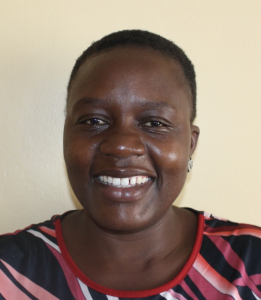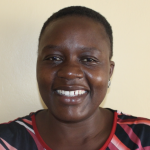"We are glad we have water nearby, but our water is not safe for drinking. In most cases, we find our water looking like milk. Last year I suffered from amoeba for a long time and spent a lot of money treating it. I had to sell all of my chickens to get treatment, and this really drained me financially," recalled Mary Levi, a 48-year-old farmer, and mother in Tombo B.
Mary is 1 of 280 people who depend on Mukonesi Spring for water in Tombo B. But the Spring is open to contamination, which frequently leads to water-related illnesses such as Mary's. People have to stand directly in it to reach the water, bringing whatever soil and bacteria were on their shoes and feet into the spring. Surface runoff from the rains is another major contamination source, depositing farm chemicals, more soil, and animal waste into the water. Algae piles up on the spring edges, and the water is home to all sorts of insects.
Since Mukonesi Spring is unprotected, women have to come very early in the morning to fetch water before it gets dirty; the more people who fetch at once, the more mud gets stirred up into the water. Much time is wasted in waiting for the water to clear after several people have fetched. Women fetch water intended for drinking as early as 5:00 am to fetch the cleanest water available each day.
To fetch water, community members must scoop water from the spring's shallow water pool with small jugs or bowls. They then pour this water into their larger jerrycans. The process is time-consuming and frustrating; every scoop wastes more of their time and delays the rest of the day's activities. The scoop-pour method also brings more contaminants into the water from the container used to scoop the water.
Community members report continuous outbreaks of diarrhea, typhoid, and stomachaches among families who depend on Mukonesi Spring for water. As a result, children miss a lot of class time, and adults miss out on productive work hours at their jobs, farms, and home.
"We will be glad when our spring is protected so that we can access safe, clean drinking water," said teenager Tabitha, a primary school student in the community.
What We Can Do:
Spring Protection
Protecting the spring will help provide access to cleaner and safer water and reduce the time people have to spend to fetch it. Construction will keep surface runoff and other contaminants out of the water. With the community’s high involvement in the process, there should be a good sense of responsibility and ownership for the new clean water source.
Fetching water is a task predominantly carried out by women and young girls. Therefore, protecting the spring and offering training and support will help empower the female members of the community by freeing up more of their time and energy to engage and invest in income-generating activities and their education.
Training on Health, Hygiene, COVID-19, and More
To hold training during the pandemic, we work closely with both community leaders and the local government to approve small groups to attend training. We ask community leaders to invite a select yet representative group of people to attend training, which will then act as ambassadors to the rest of the community to share what they learn. We also communicate our expectations of physical distancing and wearing masks for all who choose to attend.
The training will focus on improved hygiene, health, and sanitation habits in this community. We will also have a dedicated session on COVID-19 symptoms, transmission routes, and prevention best practices.
With the community’s input, we will identify key leverage points to alter their practices at the personal, household, and community levels to affect change. This training will help to ensure participants have the knowledge they need about healthy practices and their importance to make the most of their water point as soon as the water is flowing.
Our team of facilitators will use a variety of methods to train community members. Some of these methods include participatory hygiene and sanitation transformation, asset-based community development, group discussions, handouts, and demonstrations at the spring.
One of the most important issues we plan to cover is handling, storing, and treating water. Having a clean water source will be extremely helpful, but it is useless if water gets contaminated by the time it is consumed. The community and we strongly believe that all of these components will work together to improve living standards here, which will help to unlock the potential for these community members to live better, healthier lives.
We will then conduct a small series of follow-up training before transitioning to our regularly scheduled support visits throughout the year.
Training will result in the formation of a water user committee, elected by their peers, that will oversee the spring's operations and maintenance. The committee will enforce proper behavior around the spring and delegate tasks that will help preserve the site, such as building a fence and digging proper drainage channels. The fence will keep out destructive animals and unwanted waste, and the drainage will keep the area’s mosquito population at a minimum.

 Protected Spring
Protected Spring
 Rehabilitation Project
Rehabilitation Project



































